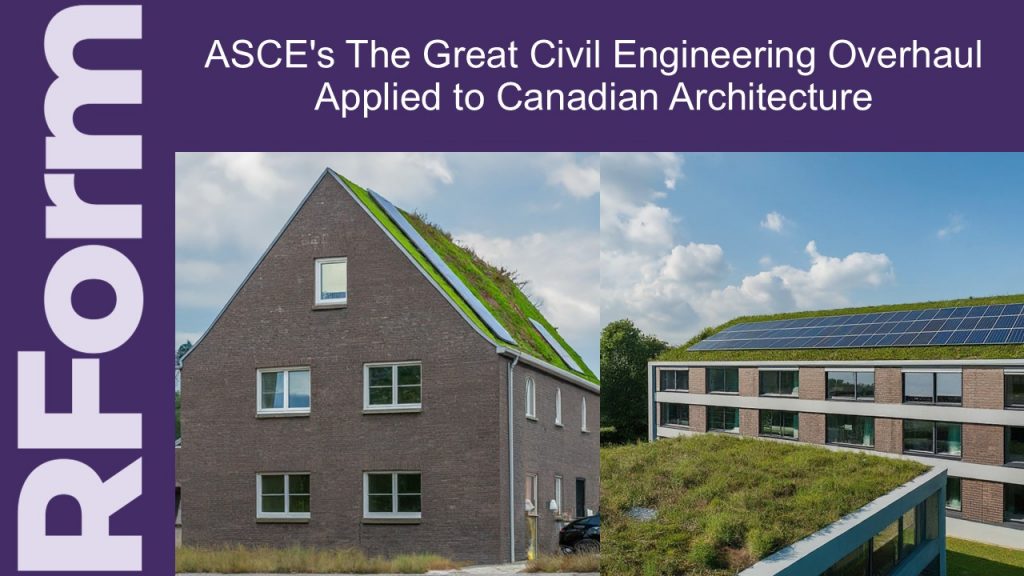
The American Society of Civil Engineers’ (ASCE) publication, The Great Civil Engineering Overhaul, serves as a wake-up call to the civil engineering profession regarding the urgent need to adapt to climate change. While primarily aimed at civil engineers, the book’s core message and recommendations are equally relevant to the field of architecture. This is particularly true in Canada, where the Royal Architectural Institute of Canada (RAIC) and the Ontario Association of Architects (OAA), among other organizations, have been actively promoting sustainability and climate resilience in the built environment.
Key Takeaways for Canadian Architects
- The interconnectedness of sustainability, climate change, and infrastructure resilience: Canadian architects must embrace a holistic view, recognizing that buildings are not isolated entities but integral components of a larger system. The principles of sustainable design and climate resilience must be woven into the fabric of every project.
- The impact of climate change on design and operation: Climate change is already affecting how we design and operate buildings. Architects must consider rising sea levels, extreme weather events, and changing precipitation patterns.
- The race to net-zero carbon emissions: Architects are crucial in helping Canada achieve its net-zero emissions target. This will require a shift towards energy-efficient buildings, using renewable energy sources, and adopting low-carbon materials.
- The need to communicate with clients about climate change: Architects need to educate their clients about the risks and benefits of sustainable design. This can help build support for climate-resilient projects.
- The importance of considering climate change in design: The failure to consider climate change in design can lead to significant risks and liabilities. Architects are responsible for ensuring their buildings are safe and resilient in the face of a changing climate.
Supporting Initiatives
- RAIC’s commitment to sustainability: The RAIC has prioritized sustainability, offering resources and programs to support architects in their efforts to design climate-resilient buildings.
- OAA’s focus on climate action: The OAA has developed a Climate Action Plan outlining the steps the association takes to address climate change. The OAA also guides architects in designing for resilience.
- Architectural Institute of British Columbia (AIBC):
- Sustainable Built Environment program: Offers courses and resources on energy modelling, passive house design, and sustainable material selection.
- Climate Action and Sustainability Committee: Advises the AIBC on policy and programs related to climate action and sustainability.
- Alberta Association of Architects (AAA):
- Sustainability Resource Hub: Provides information and tools on sustainable design practices, energy efficiency, and climate resilience.
- Sustainable Design Awards: Recognizes projects demonstrating excellence in sustainable design and innovation.
- Manitoba Association of Architects (MAA):
- Sustainable Design Committee: Develop initiatives to promote sustainability and resilience within the profession and the built environment.
- Continuing education programs: Offers courses on topics like green building certifications and climate-responsive design.
- Ordre des architectes du Québec (OAQ):
- Sustainable Development Committee: Works to integrate sustainable development principles into architectural practice and education.
- Guides and publications: Offers resources on lifecycle assessment, sustainable materials, and building performance.
- Nova Scotia Association of Architects (NSAA):
- Sustainability Task Force: Focuses on developing strategies and resources to address climate change and promote sustainable design.
- Advocacy efforts: Promotes policies and regulations that support sustainable building practices.
- Canadian Architectural Certification Board (CACB):
- Research Initiatives: Funds research on the profession’s critical issues, including climate justice and social justice.
- Syllabus and Accreditation: Ensures architectural education programs address sustainability and resilience.
- RForm.ca Bulletins:
- These bulletins provide valuable information on various topics related to sustainable and resilient building practices, including affordable housing.
- Canadian Architectural Certification Board (CACB): The CACB plays a key role in ensuring that architectural education programs address sustainability and resilience.
These initiatives demonstrate a collective commitment by Canadian architect associations to promote sustainable design and climate resilience in the built environment. By working together, these organizations are helping to create a more sustainable and resilient future for Canada.
Conclusion
The insights from The Great Civil Engineering Overhaul provide a valuable roadmap for Canadian architects as they navigate the challenges of climate change. By embracing sustainability, prioritizing resilience, and collaborating with clients and other professionals, architects can create a built environment prepared for an uncertain future.
References
- Most Canadian Associations are listed on the RForm Resource Page: https://rform.ca/resources/
- The American Society of Civil Engineers (ASCE) publication, The Great Civil Engineering Overhaul by Bill Wallace
- RForm Bulletin 24-0303: Ling Project Timelines (Affordable Housing): https://rform.ca/long-project-timelines/

